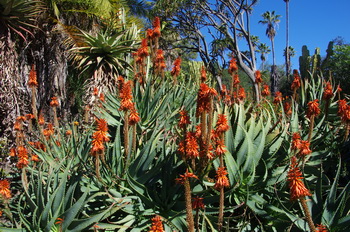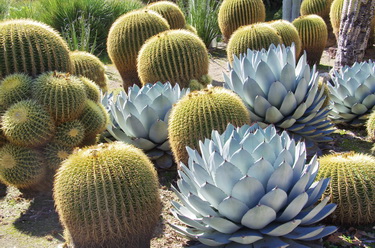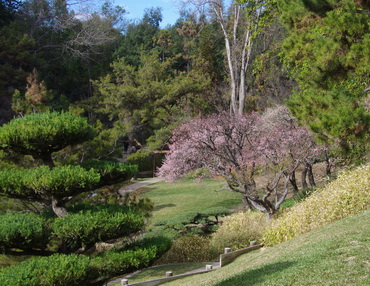Huntington Gardens Pasadena
A Must See Garden Destination
Huntington Gardens in Pasadena California should be every gardener’s must see list.
I would have liked to have discovered it when my legs were a bit younger so that I could cover more of its 120 acres in one day. Like many great gardens it was the estate of a very successful family from early industrial years in the 1900s. The Huntingtons were industrialists and railroaders who amassed a fortune and spent some of it developing this grand estate and its gardens. The house is now an art museum on the site and some day I’ll get back there to tour it. The garden is divided into several areas or rooms that feature different plants or regions of the world and the diversity is amazing.
The Desert The Huntington desert garden is an incredible display of arid zone plants from around the world. In late January when I was there it was a blaze of colour. We all have a 15cm (6") pot of Aloe Vera in one of our windows and possibly a couple of others if we are interested in succulents. Aloes in the wild during blooming season are something else entirely. Hardly recognizable as the small house plants we tend. Everywhere we looked there was a mass of blooms in reds, oranges and yellows. None of the individual blooms was that great but the Aloes carry them in huge sprays of intense colour. Their size is also a surprise to those of us who keep them indoors. Some species were 2 - 3 meters, (7-10') tall and occasionally branched as well.
Cactus We eventually wandered out of the old world section and into the America’s section of Huntington Gardens where the true Cacti are found in their may shapes and forms. It’s all still part of the huge desert garden but that garden is subdivided geographically. Few of the Cacti were blooming but they are so diverse in size shape and texture that they are a delight at anytime. To see them used in such mass plantings is to completely rethink the possibilities for dry area gardens. Now if we could only make them hardy enough to survive in my part of the world. Snow and Cacti are usually not a good combination. Mixed among the Cacti were a wonderful selection of Agaves. One particular planting of mixed Golden Barrel Cacti and a compact light blue Agave hybrid made us stop and grab cameras. There were many more, lesser known, succulents in these gardens and seeing how they were employed in the garden design suggests that they should be more well known and used. Many of these delights will make reasonably good house plants for those of us in less hospitable climes. Minimal care and lots of light can produce a very interesting indoor garden incorporating these fascinating but somewhat unfriendly plants.

I admit to having an affinity for Bamboo and that’s probably because I cannot grow it. Walking down pathways of tall timber Bamboo,
Bambusa oldhamii as it moves and rattles in the wind is a wonderful experience and somehow very calming. There were several areas of other species of Bamboo at Huntington that were equally interesting but not quite as impressive as the 10 meter, (70') stalks of the Oldham. Walking from the hot shadeless sun in the desert garden, immediately into the dense shade of a Bamboo grove is a very welcoming transition.
Oriental spaces. Huntington Gardens has both a Japanese and a Chinese garden that are at the opposite ends of a small river. The subtle differences between the two styles are made much more obvious when you can move, down a short path, directly from one to the other. If you happen to visit during Chinese New Year as we did you will find much decoration and activity at the Chinese end of that trail. Water features prominently in both of these garden styles and that is a challenge in a part of the world where water is becoming a scarce resource. The cleverly crafted rivers and waterfall are an amazing example of mixing the real and man made. It take careful examination to see the shotcrete that underlies the natural rocks and makes the waterways, waterproof. That allows the large water areas to re-circulate all of the water and be sustainable in such an arid climate. There is also a subtle shift in the types of plants and they way they are arranged as you compare the two gardens. Carefully shaped, large, individual plants such as contorted Pines are prominent in the Japanese area.
I will be returning to
Huntington in September and am looking forward to seeing more of this amazing garden. Even more so, I will anxious to see how different some of the areas look at a different time of year. Will the Aloes still have any bloom?? Don’t ever pass up the opportunity to spend a day at Huntington Garden in Pasadena California.
You can
search my entire site for answers to your gardening questions or sign up below for my free ezine.
Return from Huntington Gardens to garden visits, main page




